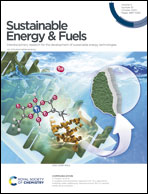Bare and polyelectrolyte-coated calcium carbonate particles for seawater uranium extraction: an eco-friendly alternative†
Abstract
Large scale extraction of uranium from oceans for energetic or decontamination purposes is becoming credible as more and more efficient adsorbing materials are developed. Although these sorbents are intended to be massively spread in ecosystems, there is still a lack of eco-friendly solutions. Calcium carbonate is a biocompatible material naturally present in marine environments. In this study, pure CaCO3 particles and their hybrid versions coated with poly(acrylic acid) (CaCO3-PAA) and poly(ethyleneimine) (CaCO3-PEI) are presented as environment-friendly alternatives. Uranium extraction capabilities of CaCO3, CaCO3-PAA and CaCO3-PEI were assessed in artificial seawater containing 2.8 to 10 000 ppb of uranium in order to simulate both natural and contaminated conditions. Stability of uranium/particle complexes was also investigated. CaCO3 and CaCO3-PEI are suitable for uranium harvesting at 2.8 ppb (removal rate > 62%) while all types of particles perform excellently under highly contaminated conditions with an advantage for CaCO3-PEI which shows the best selectivity toward uranium. Polyelectrolyte coatings were found to stabilize uranium/particle complexes whereas taken up uranium was almost completely self-released from bare CaCO3 over 6 days. Such behavior, in addition to CaCO3 biocompatibility, efficiency and cost-effectiveness, opens the way for simplification of extraction processes as no desorption step is required.



 Please wait while we load your content...
Please wait while we load your content...